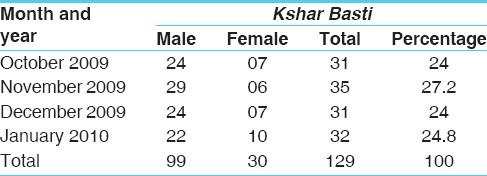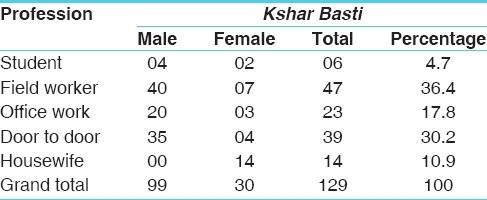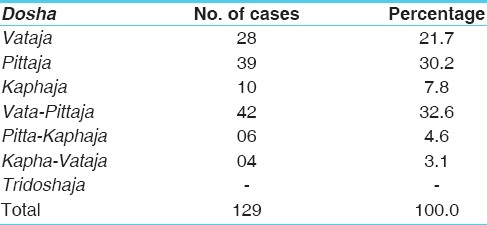Abstract
Shonitarsha is a common affliction which has been described and treated since the beginning of human civilization. Hemorrhoidal cushions are a part of normal anatomy but become pathological when swollen or inflamed. Treatment of piles in modern medicine is hemorrhoidectomy which results in repeated recurrences. Ayurveda provides a cure and prevents recurrences. Present study was carried out using a combination of Apamarga Kshara Basti and Triphalaguggulu. The results of the clinical assessment of the indigenous formulation on 129 patients with bleeding piles are reported in this paper; 55 patients of a total of 129 showed marked relief.
Keywords: Ayurveda, bleeding piles, Kshara Basti, Shonitarsha, Triphalaguggulu
Introduction
Several theories for the pathogenesis of haemorrhoids exist but none have been proven to be universally correct. Hemorrhoids are classified into two types depending on their level in relation to anus.[1] They are classified as internal and external piles.[2] Internal piles are further classified into four degrees depending on the symptoms produced.[3]
Depending on the symptoms, haemorrhoids are classified as follows:
Grade I: The hemorrhoids do not prolapse, only bleeding from the rectum is there.
Grade II: The hemorrhoids prolapse upon defecation, but spontaneously reduce.
Grade III: The hemorrhoids prolapse upon defecation, but reduce after manipulation.
Grade IV: The hemorrhoids are prolapsed and remain prolapsed.
Due to the high prevalence rate, efforts are being made by researchers to come up with a wide spectrum of treatment modalities. Word Arsha defines; “Arshamsitasmatucchategudamarganirodhat,” something which obstructs the anal canal called “Arsha;” however, Ayurvedic scholars co-relate Arsha with “hemorrhoids.” Hemmorhoids are considered to be stubborn, whereas Ayurveda provides the best alternative management as it acts on the root cause of the disease. Since there is no surgical intervention, hence there are no chances of complications like infection, bleeding, or any other thing. It is also the cost-effective and affordable treatment for people of developing countries.
The present study was conducted using the ancient Ayurvedic literature. Kshar Basti was tried with the oral administration of Triphalagugggulu.[4]
Aim and objective
The aim of this study was to see the efficacy of the combination of Kshara Basti and Triphalaguggulu in patients of Shonitarsha.
Materials and Methods
Population and sample
Patients with hemorrhoid grade I-III registered in the Ksharasutra clinic of Ayurvedic Central Research Institute of Ayurveda, New Delhi, were randomly selected.
The period of study was from October 2009 to January 2010. Patients were reviewed on weekly basis for a total of 12 months. Written informed consent was taken from all patients prior to embarking on the examination and treatment. The research subjects were examined and investigated as per the protocol. Findings in each case were recorded over a follow-up of 6 weeks. A total of 129 cases (20-60 years of age) of either sex were selected.
Hemorrhoids were of first, second, and third grade with any of the clinical symptoms such as hemorrhage, pain with constipation, prolapse of pile mass, mucus discharge, itching, and anemia.
Exclusion criteria were having nonbleeding piles, prolapse of the rectum, fissure/fistula-in-ano, abscess, malignancy, Crohn's disease, ulcerative colitis, rectal polyp, diverticulitis, diabetes mellitus, or hypertension.
Withdrawal criteria were development of severe drug reactions, profuse bleeding, or occurrence of any other serious illness.
Trial drug and duration
Kshara Basti, 2 g, was given with 10 ml of normal water in the form of Matra Basti once in a week.
Triphalaguggulu, 500 mg, was given twice a day with normal water.
The trial treatment period was of 6 weeks.
Dietary regimen
The patients were directed to follow dietary restrictions according to the etiology of hemorrhoids. Apart from this, all the patients were restrained from taking other medications, internally or externally, strong and spicy foods, coffee, tea, increased quantity of milk and milk products, condiments, and other food items supposed to be possessing medicinal value during the study period, and advised to take a regular and proper fibrous diet with adequate quantity of water.
Diagnostic criteria
Clinical diagnosis was done by assessing the presenting signs and symptoms of seven international criteria for hemorrhoids such as bleeding, pain, difficulty in passing stool, protrusion, etc. Confirmatory tests like digital rectal examination and proctoscopy were also done in each case.
Laboratory investigations
The following investigations were carried out:
Hematological investigations: Hb%, TLC, DLC, ESR.
Coagulation profile: bleeding time, clotting time.
Biochemical investigations: Blood sugar and lipid profile.
Urine examination: routine and microscopy for albumin, sugar and casts, crystals or microorganisms.
Follow-up
Patients were asked to come for clinical assessment once in 7 days for a period of 6 months.
Observation and Results
The month wise distribution of patients is shown in Table 1.
Table 1.
Distribution of patients for Kshar Basti for hemorrhoid

Sociodemographic characteristics of the study group
It was found that the prevalence of hemorrhoids was more among vegetarians, n = 95, i.e., 73.6% [Table 2].
Table 2.
Distribution of patients according to dietary habits

In this study, the prevalence was found to be more in people engaged in strenuous work, i.e., highest in field workers (36.4%), followed by people engaged in door to door activities (30.2%; Table 3).
Table 3.
Distribution of patients based on lifestyle

Out of 129 patients selected, it was observed that the people of lower socioeconomic class (52.7%) were more affected with hemorrhoids [Table 4].
Table 4.
Distribution of patients according to the socioeconomic class

Table 5 shows that among 129 cases, patients having lower level education were predominantly affected with hemorrhoids.
Table 5.
Distribution of patients according to education

Disease criteria used for assessment
The following criteria were used:[5,6]
Hemorrhage per rectum
Pain with relation to defecation
Constipation
Protrusion of pile mass
Mucus discharge
Itching of anus
Anemia.
Four scores were given according to the intensity and frequency of symptoms of the above criteria [Table 6].[5,6]
Table 6.
Distribution of patients according to clinical presentation

According to the International criteria for the diagnosis of Haemorrhoids, five groups were named based on the presence of number of clinical features. Among them, the group covering the five criteria possessed the highest number of cases (32) in this study.
It was observed that patients having Vata-Pitta doshas showed the highest prevalence (32.6%) among the patients of hemorrhoids [Table 7].
Table 7.
Involvement of prakriti

Therefore, the observed difference between mean Hb% before treatment (11.7 g%) and after treatment (12.7 g%) is statistically significant (P < 0.05; Table 8).
Table 8.
Result of the analysis of Hb% before and after treatment

Discussion
Based on the etiology of the tri-doshic concept, the mode of treatment in Ayurveda is to rectify the pathology through the diet and drugs. Constitutional peculiarities of a person are also attributed to the preponderance of the different doshas in him/her even at the time of conception. A herbal remedy is made from a medicinal plant(s) and used to prevent as well as to treat diseases and ailments or to promote healing and health. Therapeutic objectives in piles are shrinkage of pile mass, subsiding inflammation and infection in the anal region, preventing bleeding from the rectum, curing itching in the anal region, and relieving constipation as well. The use of Apamarga Kshara which is an astringent by nature immediately helps in stopping bleeding due to its Rakta Stambhana Karma. Apamarga (Achyranthus aspera) Kshara despite the Ushna and Tikshna in nature, acted in Matra Basti (2 g in 10 ml water once in a week) due to its Kashaya nature. The present treatment regimen associated with the detoxifying and rejuvenating actions of oral Triphala along with the anti-inflammatory and anti-infective action of guggulu was found to have a marked effect in treatment of hemorrhoids. Triphala also heals the tissue along with increasing the digestion of the patient at the same time acting as a mild laxative. It is one of the ancient Ayurvedic formulations as per Sharangdhara Samhita.[7] Ingredients of Triphalaguggulu tablets were Emblica officinalis (Amla), Terminalia chebula (Hareetaki), Terminalia bellerica (Vibheetaki), Piper longum (long pepper), and Commiphora mukul (Guggulu). Triphala is well known for its wound-healing quality. It also soothes the inflamed mucous layer and helps in checking the further infection. Guggulu is one of the best known anti-inflammatory herbs of Ayurveda. It also helps in healing the inflammation of fistula-in-ano. Triphala helps in easy bowel movements and relieves the constipation, a problem often troubling the people suffering from hemorrhoids. Piper longum helps in the digestion and assimilation of food nutrients. Owing to Vata Shamaka, Shothahara, Vatanulomaka, Amahara, and Vrana Ropaka properties,[8] Triphalaguggulu is one of the best oral remedies for hemorrhoids. The Kshara acts as a powerful debridement agent and selectively acts on the unhealthy tissues, pus pockets, etc. This process of debridement and healing starts from deeper tissues and travels toward periphery in stages.
This is what the compounded trial drug has done, totally healing hemorrhoids of I-III degree in a markedly improved form in the final result [Table 9].
Table 9.
Total result-wise distribution of the patients

Conclusion
The modern lifestyle which includes taking junk, spicy, and nonfibrous food with sedentary habits gives more incidences of piles.
In the present trial, the local use of Apamarga Kshar Basti, 2 g, with 10 ml of normal water, in the form of Matra Basti once in a week with the oral use of Triphalaguggulu, 500 mg twice a day for 6 weeks, has been tried in 129 cases of haemorrhoid under strict criteria of inclusion at ACRI, New Delhi, during a period from October 2009 to January 2010.
The maximum prevalence was seen in 95% males as they are engaged in strenuous works, followed by 95 (73.6%) vegetarians probably consuming less fiber and Ruksha Ahar, 47 (36.4%) field workers as they are more prone to constipation and develop the habit of consuming Ruksha and malnutrient food, 68 (52.7%) from lower socioeconomic conditions because of less attention toward food habits and hygiene; 47 studied up to school level and therefore had lack of awareness about nutrition. A total of 42 were having Vata and Pitta Dosha involvement out of 129 total patients.
The 1.0 g% rise in hemoglobin was noticed during the trial, which may be due to stopping of bleeding with Kshar Basti within 7 days of trial.
A marked relief in 55 out of total 129 patients encourages this trial further with larger samples and with comparison with other standard groups.
References
- 1.Gray DJ. Rectum and anal canal. In: Gardner SE, Gray DJ, Rahilly RO, editors. Anatomy. 4th ed. Philadelphia: WB Saunders; 1975. p. 486. [Google Scholar]
- 2.Gass OC, Adams J. “Hemorrhoids: Etiologyand pathology”. Am J Surg. 1950;79:40–3. doi: 10.1016/0002-9610(50)90189-9. [DOI] [PubMed] [Google Scholar]
- 3.Church JM. Analysis of the colonoscopic findings in patients with rectal bleeding according to the pattern of their presenting symptoms. Dis Colon Rectum. 1991;34:391–5. doi: 10.1007/BF02053689. [DOI] [PubMed] [Google Scholar]
- 4.Sharma PC, Yelne MB, Dennis TJ. Database on medicinal plants used in Ayurveda, CCRAS. Department of ISM and H. Govt. of India. 2001;2 [Google Scholar]
- 5.Kent JT. Repertory of the HomæopathicMateriaMedica (B. Jain) [Google Scholar]
- 6.Tiwari SK. Essential of Repertorization (B. Jain) [Google Scholar]
- 7.Murti, Srikanta K.R., Prof . SarangadharaSamhita. 1st ed. Varanasi: ChowkhambaOrientalia; 1984. [Google Scholar]
- 8.Mehra Raakhi., Dr., editor. New Delhi: ChaukhambhaOrientalia; 2005. Vran and its Healing. [Google Scholar]


